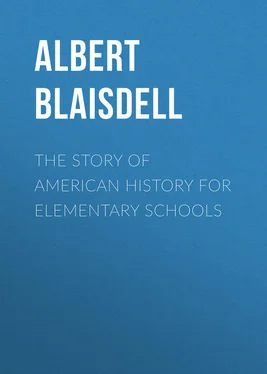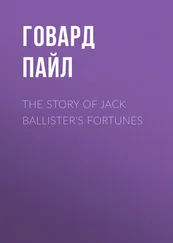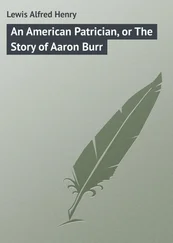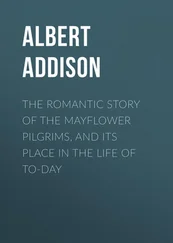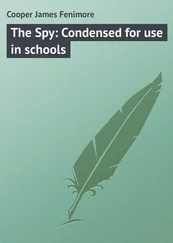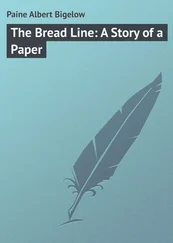Albert Blaisdell - The Story of American History for Elementary Schools
Здесь есть возможность читать онлайн «Albert Blaisdell - The Story of American History for Elementary Schools» — ознакомительный отрывок электронной книги совершенно бесплатно, а после прочтения отрывка купить полную версию. В некоторых случаях можно слушать аудио, скачать через торрент в формате fb2 и присутствует краткое содержание. ISBN: , Жанр: foreign_antique, foreign_prose, Историческая проза, на английском языке. Описание произведения, (предисловие) а так же отзывы посетителей доступны на портале библиотеки ЛибКат.
- Название:The Story of American History for Elementary Schools
- Автор:
- Жанр:
- Год:неизвестен
- ISBN:http://www.gutenberg.org/ebooks/34600
- Рейтинг книги:5 / 5. Голосов: 1
-
Избранное:Добавить в избранное
- Отзывы:
-
Ваша оценка:
- 100
- 1
- 2
- 3
- 4
- 5
The Story of American History for Elementary Schools: краткое содержание, описание и аннотация
Предлагаем к чтению аннотацию, описание, краткое содержание или предисловие (зависит от того, что написал сам автор книги «The Story of American History for Elementary Schools»). Если вы не нашли необходимую информацию о книге — напишите в комментариях, мы постараемся отыскать её.
The Story of American History for Elementary Schools — читать онлайн ознакомительный отрывок
Ниже представлен текст книги, разбитый по страницам. Система сохранения места последней прочитанной страницы, позволяет с удобством читать онлайн бесплатно книгу «The Story of American History for Elementary Schools», без необходимости каждый раз заново искать на чём Вы остановились. Поставьте закладку, и сможете в любой момент перейти на страницу, на которой закончили чтение.
Интервал:
Закладка:
Among some of the tribes, bands of wampum were woven into ornamental belts, and these were decorated with colored beads combined into striking figures and designs. The wampum belts were often given as a pledge that the giver would faithfully live up to certain terms of a treaty.
73. Indian Tools and Snowshoes.– As the Indians had so little to work with – no iron for knives, nor tools of any kind except flinty stones made sharp and called "hatchets" – it is wonderful how ingenious they were in supplying their personal wants. They kneaded in oil and softened with heat the furry skins of animals, and from these they made excellent garments for winter. From dried deerskins they fashioned a sort of soft serviceable shoe called the "moccasin." This was wrought from a single piece of the leather. It fitted snugly to the foot and was tied with strips of buckskin at the ankle.
The danger of starving in the winter when the snow was deep led the Indians to invent the snowshoe. This was made of a light framework of ash, filled with meshes of rawhide, thus presenting a broad surface to the snow. By this contrivance the Indians could travel in winter as easily as in summer.
It is said that an Indian upon snowshoes could easily travel forty miles a day. Strangely enough, all the cunning of the white man has never availed to make anything better for such a purpose.
74. Indians as Hunters.– The Indian contrived ingenious traps for catching bears, moose, and other sorts of game. One of these devices consisted of a long and heavy log, carefully balanced upon a post placed upright in the ground, with a log attached to one end of it. The roving animal would approach, and by jumping attempt to get the bait that was so attractive. The movement would cause the log to fall, and thus, perhaps, the creature would be killed.
Fish were killed by shooting them with the arrow as they swam; or they were caught with hooks of bone, or taken in rivers by means of a weir, or brush fence, fixed across the stream. Sometimes they were taken in nets woven from the bark of the elm, and in traps of wickerwork not unlike the lobster pots now in use.
The Indians had a remarkable faculty, resembling that of the ventriloquist, whereby they could imitate the voices of woodland creatures – the hoot of the owl, the cry of the wild turkey, the howl of the wolf. By this means they could readily attract animals of various species to a spot where they might easily kill them. Even hostile Indians out searching for game were in this manner sometimes allured to the place of danger.
75. Story illustrating the Indian's Keen Observation.– It is marvelous what quick eyes the Indian had to see almost instantly things that other persons would never see at all. The story is often told of an Indian who returned one day to his wigwam and found that a large piece of venison had been stolen. He looked carefully around, and then started off for the thief. He asked the first man he met if he had seen a little old white man with a short gun and a small dog with a short tail. Afterwards he explained how he learned all these points. He said he knew the thief was little, for he had to pile up some stones to reach the venison; old, by his short steps; white, by the toes of his tracks turning out; that he had a short gun, for when it fell to the ground from where it leaned against the tree, it made a short mark in the dirt. He knew by the dog's track that the dog was small; he knew that the dog had a short tail, because a short groove had been "wiggled" in the dust where the dog had sat while his master was stealing the meat!
76. The Indians were Cruel, Cunning, and Revengeful.– As to character, the Indian had, like all the rest of us, a good and a bad side. Though usually silent and moody in the presence of white men, travelers tell us that the Indians had lively games when by themselves, and enjoyed fun and frolic and story-telling like other people. They were crafty and treacherous, as well they might be from their constant warfare.
They were cruel and remorseless in their revenge, and they never forgot a wrong. Full of cunning, they took pride in ingenious tricks. They would wear snowshoes with the toes turned backwards, that the enemy might think they had gone the other way! In their homes they were filthy, lazy, and improvident. They were passionately fond of gambling, after they had learned it of the whites!
On the other hand, they were patient of hunger, cold, and fatigue, and were wonderfully brave. They were hospitable to an acquaintance in need, even sharing the last of their food with him. They were grateful for benefits, and never forgot a kindness. Their promise was almost sacred, and the pledge of their chief was rarely broken.
When the early settlers in this country treated the Indians kindly, they usually received kindness in return, as we shall see later in reading William Penn's dealings with the Indians in Pennsylvania. But now and then some rude white man was cruel or dishonest in dealing with them, and then he learned that the red man knew what revenge means.
If any serious offense was given to the Indians they brooded over it, and then, eager to inflict more harm than they had suffered, instead of punishing the offender alone, they spent their revenge upon all they could reach of the white race. So they sprang suddenly upon peaceful villages and cruelly killed innocent men, women, and children.
77. Anecdote of Tecumseh.– The true Indian warrior had a certain proud dignity that challenged respect. At a great council of the government with the Indians, the famous Indian chief, Tecumseh, after he had made a speech, turned to take a seat, when it was found that by accident no chair had been placed for him. General Harrison instantly called for one. It was brought by the interpreter, who said, "The Great Father wishes you to take a chair." "My father!" he said with dignity, as he wrapped his blanket about him to seat himself in Indian style upon the ground; "the Sun is my father, the Earth is my mother, and on her bosom will I repose."
78. Care and Training of the Indian Children.– The care and training of Indian children were peculiar. When the little papoose was very young, it was not fondled nor much attended to. Quite early it was placed in a small trough of bark and strapped in with a mat or skin in front, the little bed being padded with soft moss. This bit of a cradle was handy to carry around, to lean against a log, or to hang up in a tree.
As they grew up, they were as happy as other children. Their parents made toys for them, and their older mates taught them songs and games. As soon as they were large enough, each had his share of work to do. The girls had to help their mothers to dress skins for clothing, to bring wood and water, and to work in the rude garden.
79. The Indian Boy's Early Training.– The Indian boy was early trained for hunting and war. His first lessons were to manage his bow and arrows, and then he was taken into the woods to shoot. He was taught to set traps for small game, and his father often slyly put some animal in the snare to encourage the young hunter.
So the boy was taught, not arithmetic and grammar, but all about birds – their colors, their different whistles and cries, and what each note means; their food and habits, where they nest, how they fly, and the best way to shoot them. His lessons included the study of rabbits and squirrels, of beavers and foxes, and of all such game.
By the time the Indian boy had seen twelve or fourteen snows , as the Indian would say, he could make his own bows and arrows and could help make canoes. He had received many lessons about shaping tomahawks and war clubs, and how to use them. Playing ball was a favorite game with Indian youth. Catlin, the celebrated authority on Indian life, tells us that he used to ride thirty miles to see a ball game, and would sit on his horse all day to see a match played by six to eight hundred or even a thousand young Indians.
Читать дальшеИнтервал:
Закладка:
Похожие книги на «The Story of American History for Elementary Schools»
Представляем Вашему вниманию похожие книги на «The Story of American History for Elementary Schools» списком для выбора. Мы отобрали схожую по названию и смыслу литературу в надежде предоставить читателям больше вариантов отыскать новые, интересные, ещё непрочитанные произведения.
Обсуждение, отзывы о книге «The Story of American History for Elementary Schools» и просто собственные мнения читателей. Оставьте ваши комментарии, напишите, что Вы думаете о произведении, его смысле или главных героях. Укажите что конкретно понравилось, а что нет, и почему Вы так считаете.
